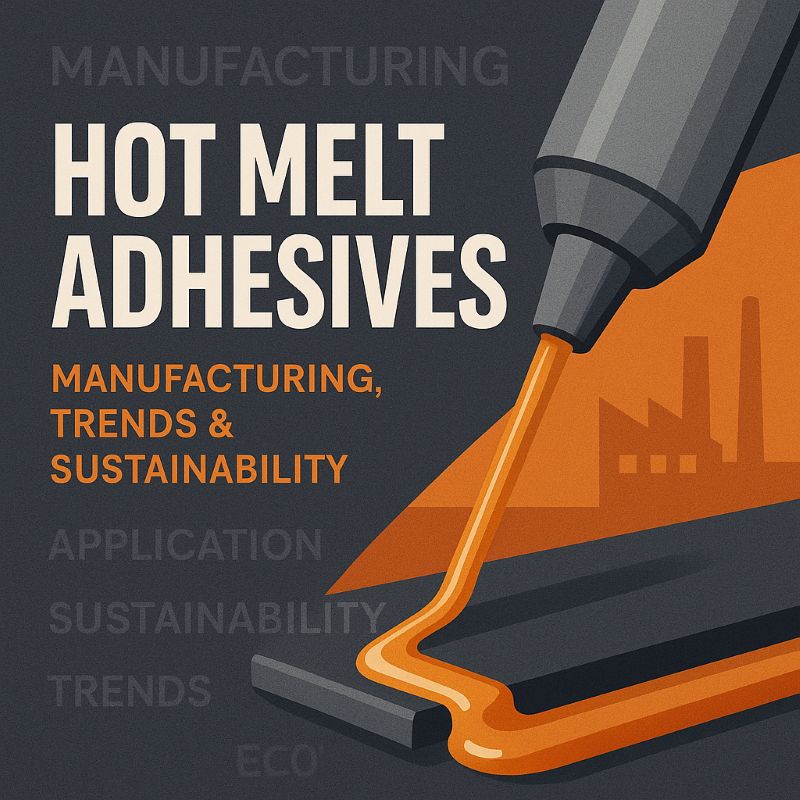
Definition of Hot Melt Adhesives
Types of Hot Melt Adhesives
Importance in Manufacturing
Manufacturing Methods Overview
Latest Trends in Adhesives
Strategic Applications
Environmental Considerations
Frequently Asked Questions (FAQ)
Hot melt adhesives (HMAs) are thermoplastic bonding materials applied in molten form and solidified upon cooling, providing rapid and durable adhesion. Their fast-setting nature makes them ideal for high-speed industrial environments such as packaging, electronics, woodworking, and automotive assembly. High-performance HMAs are chosen for their stable bonding, clean application, and compatibility with various production systems.
HMAs are available in multiple formulations, each designed for specific applications:
Ethylene-vinyl acetate (EVA): Cost-effective and widely used in packaging.
Polyolefin: Resistant to heat and chemicals, ideal for automotive and electronics.
Polyamide: Known for high durability and chemical resistance, often used in electrical and textile applications.
Polyurethane (PUR): Offers flexibility and strong adhesion, suited for woodworking and construction.
Each type provides unique benefits tailored to performance and durability needs across manufacturing sectors.
Hot melt adhesives are essential in modern manufacturing due to their rapid bonding speed and versatility. They significantly reduce curing time, increase production throughput, and ensure consistent product quality. These adhesives are critical in fast-paced sectors such as packaging, electronics, and automotive, where reliable bonding under pressure is a must. Modern HMAs offer robust adhesion and adaptability across materials, enhancing operational efficiency and reducing production costs.
Producing high-quality hot melt adhesives involves precise material selection and blending. Resins, waxes, and polymers are melted and mixed to create uniform adhesive formulations. These mixtures are then processed into usable forms such as pellets, blocks, or sticks. Manufacturing techniques like extrusion or molding influence the final adhesive properties, including set time, viscosity, and strength. Proper formulation ensures compatibility with both manual and automated application systems.
Recent advancements in the adhesive industry reflect a focus on sustainability, efficiency, and innovation:
Bio-based and low-VOC adhesives reduce environmental impact.
Low-temperature melting formulations help conserve energy and protect heat-sensitive substrates.
Smart manufacturing integration ensures quality consistency with real-time monitoring and process automation.
These trends are shaping the next generation of adhesives, offering better performance with fewer environmental trade-offs.
Hot melt adhesives serve as essential solutions across various industries:
Packaging: Rapid bonding and sealing optimize high-volume throughput.
Automotive: Adhesives with heat and chemical resistance ensure secure component bonding.
Woodworking: Flexible, strong adhesives accommodate wood expansion and stress.
Electronics: Precision bonding in tight spaces demands HMAs with stable thermal and dielectric properties.
These applications demonstrate the strategic role of HMAs in enhancing production quality and adapting to industry-specific requirements.
Eco-conscious production is increasingly central in adhesive development. Manufacturers are adopting:
Bio-based polymers to reduce reliance on petrochemical sources
Low-temperature curing adhesives to minimize energy usage
Closed-loop recycling and waste reduction systems in production facilities
Such efforts ensure that hot melt adhesives align with global sustainability goals while maintaining high-performance standards.
Q: What are hot melt adhesives?
A: Thermoplastic bonding materials that are applied in molten form and quickly solidify to create strong, durable bonds.
Q: What types of hot melt adhesives are available?
A: EVA for packaging, polyolefin for automotive, polyamide for electronics, and polyurethane for woodworking.
Q: Why are hot melt adhesives important in manufacturing?
A: Their fast bonding speeds enhance productivity and reduce downtime in high-speed production environments.
Q: How are hot melt adhesives manufactured?
A: By melting and blending selected raw materials into a homogeneous mix, then extruding or molding into usable forms.
Q: What are the latest trends in hot melt adhesives?
A: Bio-based materials, energy-efficient low-temp formulations, and smart process integration.
Q: What are some strategic applications?
A: Used in packaging for sealing, automotive for heat resilience, woodworking for strength, and electronics for precision.
Q: How do environmental considerations factor into adhesive manufacturing?
A: Through the adoption of sustainable materials and energy-efficient production practices.
Q: What types of hot melt adhesives are best for general use?
A: High-purity, fast-setting adhesives that offer strong adhesion across diverse materials and work well in automated systems.